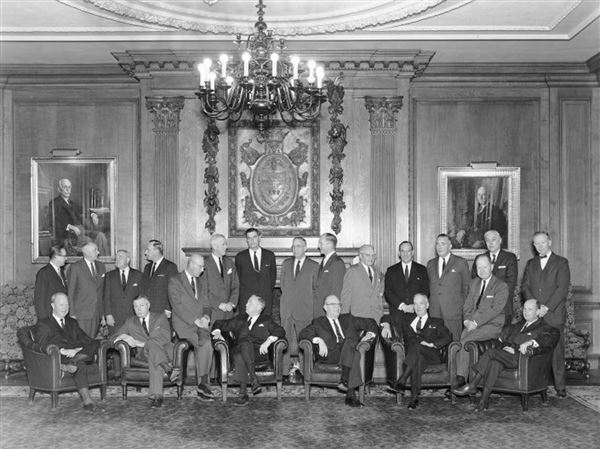Simms Taback won the Caldecott Medal -- given for the best illustrated children's book of the year -- for "Joseph Had a Little Overcoat" in 2000.
That book and his 1998 Caldecott Honor-winning (Caldecott Medal runner-up) book, "There Was an Old Lady Who Swallowed a Fly," remain hugely popular with young readers. But Mr. Taback liked to joke that when he spoke to groups of kids, they were most impressed by the fact that he designed and illustrated the initial packaging for McDonald's "Happy Meals."
Mr. Taback, whose personality was as warm as the vibrant colors in his books, died on Christmas Day at the age of 79 from pancreatic cancer. With his death, the children's book world has lost one of its most innovative and entertaining luminaries, someone who worked hard to create books that were fun for children to read.
Mr. Taback's folk-art style, vivid colors and quirky humor are instantly recognizable in his books, whether he worked in watercolors, as in his picture book "I Miss You Every Day," or created collage illustrations, as in "Joseph Had a Little Overcoat."
All in all, he illustrated and/or wrote more than 40 children's books, including beginning readers, such as "Sam's Wild West Show" (written by Nancy Antle); nonfiction books, such as "Road Builders" (written by B.H. Hennessy); joke books, such as "Snakey Riddles" (written by Katy Hall and Lisa Eisenberg); and picture books, such as "This Is the House That Jack Built," based on the traditional rhyme.
Both "Joseph Had a Little Overcoat" and "There Was an Old Lady Who Swallowed a Fly" use die-cut holes in the pages to help tell the story. In "Joseph," the holes show how the overcoat grows smaller and smaller, becoming a jacket, a vest, a tie and a button. The die-cut holes in "Old Lady," meanwhile, depict the ever-increasing crowd of animals in her stomach.
By using die-cut holes, Mr. Taback broke new ground in children's literature, notes Anita Silvey, a children's book expert who writes the "Children's Book-a-Day Almanac" (http://childrensbookalmanac.com).
"Both ... 'There Was an Old Lady Who Swallowed a Fly' and 'Joseph Had a Little Overcoat' were the first books using die-cut holes to be so honored," Ms. Silvey said.
"This technique had begun with Peter Newell's 'The Hole Book' at the beginning of the 20th century, but such books had always been considered 'toy books,' not worthy of awards."
Mr. Taback's newest book, published last year, continued his inventive tradition. Titled "Postcards From Camp" (Penguin, $17.99, ages 7-10), it presents a series of postcards and letters exchanged by a father and his young son, who is at first a very reluctant summer camper.
More the size of a novel than a picture book, "Postcards From Camp" fits into the new "hybrid" genre for kids -- best typified by the "Diary of a Wimpy Kid" series -- where the story is told in a mixture of text and illustrations. Kids will enjoy both Mr. Taback's trademark wry humor as well as his hilarious illustrations.
Born and raised in New York, Mr. Taback loved to draw and paint but initially planned on becoming an engineer to ensure himself a steady income. But there was some administrative problem with his admission to City College in New York, and, while waiting for it to be resolved, he took the entrance exam for Cooper Union, a top art school. He was accepted, and he eventually earned his bachelor's degree there.
Mr. Taback worked as a graphic designer for many years. In addition to designing the first "Happy Meal" packaging -- the prototype is now in the Smithsonian -- he created a greeting card company, illustrated posters and calendars, and served as an art director for The New York Times, among other places.
During his early years as a graphic designer, he worked in the same Manhattan building as children's illustrator Ezra Jack Keats. One day, Mr. Keats invited Mr. Taback into his studio to see the art for his new book, "The Snowy Day."
The now classic book later won the 1963 Caldecott Medal, and Mr. Taback never forgot his first look at Mr. Keats' artwork.
In a telephone interview with Scripps Howard News Service four years ago, he said: "I was very taken with that book. And I thought, 'This man is a children's book artist?' It started me off thinking about doing children's books."
By the time Mr. Taback published "Old Lady," he had already done dozens of books. "But people talked about 'Old Lady' as my 'breakthrough' book and said I had 'burst upon the scene.' That's right, after working for 35 years, I had finally 'burst upon the scene'!" he joked in the earlier interview.
Overall, Mr. Taback said he felt incredibly fortunate to be a children's book creator.
"I've always loved children's artwork," he said in the Scripps interview. "I try to take away from that, and give it back to them."
First Published: January 10, 2012, 10:00 a.m.
















